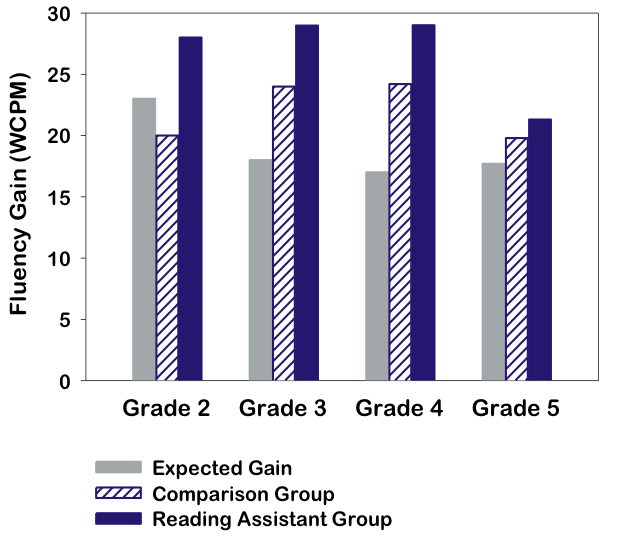Develop your students’ reading fluency, vocabulary, and comprehension during extended hours with Scientific Learning’s Reading Assistant Guided Reading Tool
The 21st Century Community Learning Centers grant “supports the creation of community learning centers that provide academic enrichment opportunities during non-school hours for children, particularly students who attend high-poverty and low-performing schools. The program helps students meet state and local student standards in core academic subjects, such as reading and math; offers students a broad array of enrichment activities that can complement their regular academic programs; and offers literacy and other educational services to the families of participating children.”
| 21st Century Criteria | Reading Assistant |
|---|---|
| Non-school hours operation | Because Reading Assistant can be monitored by regular classroom teachers, reading specialists, Special Education instructors, or community members, use of the product can occur throughout the day, during or outside of school hours, on weekends, during inter-sessions for year-round schools, and during the summer. In addition, Reading Assistant’s protocol of only 3 days per week for 20, 30, or 40 minutes (depending on the grade level) makes it flexible enough for the varying schedule of many extended hours programs. |
| Help students meet state and local student standards | Reading Assistant is aligned with English Language Learner and English Language Arts state standards, as well as the Common Core State Standards. To see alignments to your state standards, go to: www.scientificlearning.com/correlations. |
| Literacy services | Scientific Learning’s Reading Assistant software helps elementary and secondary students strengthen their reading fluency, vocabulary and comprehension by providing one-on-one reading support through real-time corrective feedback enabled by patented speech recognition technology.
Reading Assistant acts as a patient, supportive listener for emerging or struggling readers and provides the much needed reading practice that benefits all students. Readers are helped with interactive resources, immediate feedback on errors, and private playback. Teachers receive assessment reports as if they had been sitting next to their students, listening. |
| Literacy services for families of participating children | Parents and family members can:
|
| If appropriate, be based upon scientifically based research | As documented by the National Reading Panel, read-aloud sessions promote not just fluency, but also word recognition and comprehension, and the Panel urges that classroom teachers find ways to increase the time they engage their students in guided oral reading on a regular basis. Add to this the fact that 50% of students read for an average of 4.6 minutes per day outside of school[1], and the importance of extended hours reading becomes even more important. Scientific Learning’s Reading Assistant provides students with an effective one-on-one guided oral reading environment where the program “listens” as the child reads and, using patented speech recognition technology, provides individualized guidance and correction. |
Students Show Reading Fluency Gains after Guided Oral Reading Practice with Reading Assistant[2]
The research design was an experimental study using a nationally-normed measure to determine the fluency gains of students who used Reading Assistant relative to the fluency gains of students in a grade-matched comparison as well as to group expected gains. Each student’s reading fluency was assessed at the beginning and end of the study with Edformation’s Standard Oral Reading Fluency Assessment Passages.
The Reading Assistant product was used by second and third graders in one school and by fourth and fifth graders in a second school. Fourth and fifth graders from the first school and second and third graders from the second school served as the comparison group.
Students used the Reading Assistant product 30 minutes per day, two days per week, for seventeen weeks. The average number of sessions completed varied by grade, ranging from 15 sessions for the second graders to 24 sessions for the fourth graders. Reading Assistant was used during students’ scheduled computer lab time, and it did not replace or reduce instructional time in their standard reading curriculum.
Improved Reading Fluency
 On average, students who used Reading Assistant made significantly greater gains in words correct per minute (WCPM) than students who received their standard reading curriculum alone. In addition, the Reading Assistant group exceeded expectations for fluency gains based on Edformation’s normative data. The advantage for the Reading Assistant group was consistent across the four grade levels.
On average, students who used Reading Assistant made significantly greater gains in words correct per minute (WCPM) than students who received their standard reading curriculum alone. In addition, the Reading Assistant group exceeded expectations for fluency gains based on Edformation’s normative data. The advantage for the Reading Assistant group was consistent across the four grade levels.
The results found in this study demonstrate that using the Reading Assistant product to enrich reading instruction with guided oral reading practice can help students increase their reading fluency. Use of Reading Assistant strengthens foundational reading skills, better positioning students to partake in the classroom curriculum.
Phone: 888-358-0212
Email: info@scilearn.com
1 Anderson, R. C., Wilson, P.T., & Fielding, L. G. (1988). Growth in reading and how children spend their time outside of school. Reading Research Quarterly, 23, 285-303.
2 Adams, M. J. (2006). The promise of automatic speech recognition for fostering literacy growth in children and adults. In M.C. McKenna, L.D. Labbo, R. D. Kieffer, & D. Reinking (Eds.), International Handbook of Literacy and Technology, Volume 2. Mahwah, NJ: Lawrence Erlbaum Associates.



